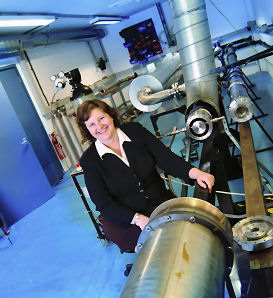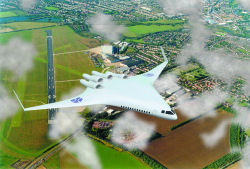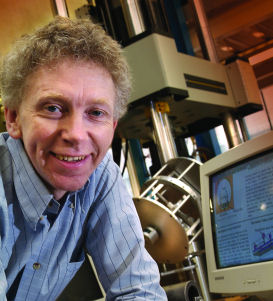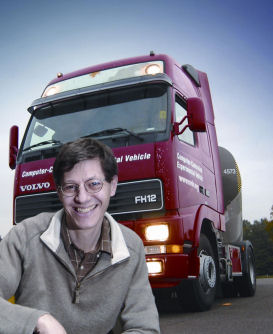Our devotion to communicating face-to-face means we're travelling more than ever before, says Louise Simpson from the The Knowledge Partnership. But take heart. For Cambridge engineers are working to transform tomorrow's transport.
Using HCCI engines gives a petrol car the economy of diesel, while reducing the need for expensive catalysts and filters.
Professor Nick Collings



Here at the Department of Engineering Professor Nick Collings emphasises the need to develop cleaner, more efficient vehicles. 'There's still a lot of concern that something "green" won't be up to the job. But we now have very effective hybrid vehicles on the market that combine a gasoline engine with a battery-powered electric motor. Storing electricity generated by braking and using it for the next acceleration means you can fit a smaller, more efficient engine that gives the feel of a powerful car. When moving slowly or stopped in traffic you just switch off. This has a huge effect on fuel economy and cuts emissions by up to 90 per cent.'
Diesel fuel is economical but it puts more particulates - soot - into the air than gasoline, bringing health problems in its wake. Professor Collings' team are therefore working on bio-fuels and diesel particle filters, as well as on new combustion systems such as Homogeneous Charge Compression Ignition (HCCI). This combines traditional spark ignition with the sort of compression ignition a diesel engine uses. Combustion takes place evenly and spontaneously without the need for a flame, which means the engine can run efficiently over a much wider range than a conventional engine.
'The main problem with the average petrol engine is that in traffic its fuel economy is terrible,' says Collings. 'Using HCCI engines gives a petrol car the economy of diesel, while reducing the need for expensive catalysts and filters.'
To optimise an HCCI engine at the research and development stage, engineers need to be able to analyse its emissions with great accuracy. Collings' team have obliged with a series of ingenious diagnostic instruments that can do just that. By fitting a small sample tube to a modified spark plug, they can extract gas from the combustion chamber and analyse a tiny sample in real time while the engine is still running. Emissions can be measured on a millisecond timescale, a technique so important for the car industry that since 1987 their instruments have been sold commercially through a spin-off company called Cambustion.
With air travel expanding even faster than car use, Professor Ann Dowling concentrates her attention on the skies. The inventor of the jet engine, Frank Whittle, undertook much of his early development work as a mature student at Cambridge, and Professor Dowling builds on his legacy today as director of the University Gas Turbine Partnership, a long-running collaboration with Rolls-Royce that keeps Cambridge aero engineering at the cutting edge of technology. 'Jet engines are amazing,' says Dowling. 'The sheer density of the energy produced - equivalent to the power of over 1,000 family-sized cars, and within a volume not much larger than a single car - means that the engineering is highly sophisticated.'
'Aside from safety, speed used to be the key priority. That's no longer the case. Our main concern now is to limit pollution; and not just pollution from carbon dioxide. The water vapour emitted at altitude by burning fuel also drives global warming. You can reduce pollutants such as nitrous oxides by altering the design of the combustion system - which makes combustion research crucial - but the only way to reduce emissions of carbon dioxide and water vapour is to improve the overall efficiency of the engine and the aircraft.'
With global warming beginning to bite, is that enough? Shouldn't we be discouraging any increase in air travel? 'Jets give about 120 passenger miles to the gallon - better than a car,' says Dowling. 'It's very unlikely people will give up travelling by plane. The challenge is therefore to use the technology responsibly by improving efficiency and minimising the environmental impact.'
Noise is the other pollutant that Dowling's team are tackling, this time in collaboration with engineers from MIT under the aegis of the Cambridge-MIT Institute. The goal of their Silent Aircraft Initiative (SAI) is to design a passenger plane that makes no more noise at take off and landing than the ambient urban noise outside the airport's boundaries. Since noise is hard to reduce through incremental changes, the team have gone back to the very basics of aircraft design and operations.
Computer simulations of the result reveal a radical redesign of what we think of as a jet aircraft. The Silent Aircraft looks more like a space craft ready to fight the Zargonoids on Zob than a plane to board for a business trip to Frankfurt: a sleek, white triangular shield with integrated wings and four stubby engines projecting from the back like organ pipes. The jets are slower and wider than on conventional planes so that they can produce the same thrust more quietly.
The integrated look contributes to the low noise performance, says Dowling. 'Noise at take off comes from the engines. With a traditional jet, these are strapped to the underside of the plane, but the Silent Aircraft embeds them in the body, with intakes on top to shield the noise from the ground. On landing, half the noise of a conventional aircraft comes from the airframe; with the Silent Aircraft, the body is of composite construction rather than metal, and its streamlined shape reduces the noise.'
The Cambridge-MIT team is using computer modelling and scaled wind-tunnel tests to develop a virtual aircraft. The conceptual design will be completed by next autumn, and within twenty years we might even be boarding one of these new-wave planes for a commercial flight. For the moment, says Ann Dowling, the aim is to get industry to rethink its ideas about aircraft design. 'By ensuring that every component of the plane is as quiet as possible and has good efficiency, we hope to encourage manufacturers to be more radical in their targets for noise reduction.'
While Dowling is rethinking aircraft design, her colleague Professor Rex Britter is taking on air pollution. Inputting measurements such as volume of air traffic, wind, temperature and the pattern of surrounding buildings and traffic, he models air quality mathematically to estimate the impact of pollution on any given place. He is currently working with government on the air quality implications of the third runway proposed for Heathrow. But his techniques have security applications too: for instance, in helping decide how best to anticipate, and deal with, a terrorist release of air-borne toxins within a city.
Although the modelling is sophisticated, says Britter, estimating the damage pollutants will do to humans is difficult. 'The effect of traffic exhaust is hard to gauge. It depends on so many factors: heat, wind direction, how a city is built, where you site the sensors, and where people stand at the bus stop. Take Cambridge. You would think that the air quality would be good. But it's not, especially on Regent Street. We're on the edge of the currently acceptable threshold. The narrow streets and the large volume of cars concentrate pollution so that it can't easily disperse.'
There's no need to flee to the Hebrides yet, though, for Britter is remarkably up-beat about how seriously Europe is working to improve air quality. 'Regulations often push science forward, but the targets are almost too tight; our American colleagues think we're unwise to be chasing the thresholds that the EU has set. There is no perfect formula. If we live within very strict green limits there will be an impact on jobs, and therefore on our social lives and health. It's all about getting the right balance. To achieve the best air quality, we might have to forfeit the best transport links needed to support a leading economy. There are social consequences in everything we do.'
Britter is especially bullish about the interdisciplinary Institute of Aviation and the Environment he has just helped set up. This will tackle air pollution by bringing engineers together with economists, applied mathematicians, chemists, architects and geographers. 'Putting amazing teams together like this is the sort of thing that Cambridge does best. In fact, it's made me think that the colleges should become interdisciplinary centres, bridging business and the University, and providing the non-departmental think-tanks the world needs.'
One obvious route to reduced pollution is integrated public transport, a cause close to the heart of Australian-born engineer Dr Hugh Hunt. 'In many parts of Europe, the bus arrives at the train station a few minutes before the train leaves,' says Hunt. 'In Britain, we build the bus station a mile from the train station and forget to schedule connections.
'Lots of countries have sorted out their inner-city transport problems by building underground railways, but the resistance in this country is incredibly high. People under whose land tunnels might be built fear they will be disturbed by rumbles, and will get cracks appearing in their homes. It's a huge barrier to solving the big transport issue of the twenty-first century.'
Hunt himself is working on ways of controlling the vibration of underground trains to make new tunnels much quieter. 'Engineers and the public need to know what the impact on buildings will be, and our computer models show that vibration can virtually be eliminated,' he says. 'We need to persuade people, because tunnelling beneath buildings is a very important solution to urban traffic. Imagine what moving round London or Paris would be like now if those early engineers hadn't had the confidence to tunnel under buildings? We should be doing the same again today, only much better.'
Dr David Cebon's team are working on a variety of projects through the Cambridge Vehicle Dynamics Consortium, which brings truck manufacturers and researchers together to improve vehicles and promote best practice. Safety is high on the agenda. 'The congestion caused by lorry accidents and the damage lorries do to roads costs the British economy billions of pounds a year,' says Cebon. 'It's particularly bad here because we're so much more congested than the United States or Australia.'
A current project involves improving the way heavy goods vehicles take corners. At junctions and roundabouts lorries tend at present to cut the corner, causing damage and accidents or simply getting stuck. Now Cebon has created a breakthrough steering system for the back of the truck that will enable these giants of the road to negotiate much tighter curves. 'Whatever the speed, the back now follows the front. Whether blown by a side wind, avoiding an obstacle on the road or encountering ice, the vehicle remains on track. It's much safer and more manoeuvrable, with a lower risk of swinging out. It also uses less fuel and has much lower tyre wear.' Cebon expects such lorries to be commercially available in the next few years.
This article is by Louise Simpson of the communications consultancy 'The Knowledge Partnership'.


